
Articles - Ten Rarities
Copyright
© 2022 Robert Farquharson All Rights Reserved
-

British Internal Airmails of the 1930’s
Orange and Blue
on Ivory Card
Orange and Blue on Ivory Card
on Ivory Card
Ten Rarities
By Bob Farquharson One of the best things about collecting British Air mails of the 1930’s is that for the most part the covers are fairly plentiful and well wthin most peoples budget. Added to that the penchant of the air mail dealers of the time to ensure that first flights were celebrated with numerous commemorative envelopes often with attractive cachets or labels. and you have a plentiful collecting field. Also the number of airlines starting in this period makes the collecting field even more fruitful. But whilst most covers can after a period of time be found there are a number of covers are much more difficult to find and that is what collecting js all about. This article lists ten of the more difficult covers to find in this period. The list is not in any order and does not pretend to be a definitive list of the most difficult to find.1.
GWR 12th April. Plymouth to Newport.

On the 12th April, GWR commenced their Cardiff – Torquay –
Plymouth service. Air mail dealers were expecting to be able to send
airmails on the flight through the existing railway stamp regulations
but at the last moment GWR said they needed special dispensation
from the Postmaster – General. A. Phillips of Newport had already
prepared his mails and decided not to be thwarted and hopped on
the plane himself and posted a number of air mails with Parcel Post
3d stamps. Phillips never said how many he posted that day,
although they are far from scarce. The one route that is not
common is the Plymouth to Newport leg, which did not have a
parcel stamp and of which only twelve were flown.
2.
International Airlines 11th September 1933.
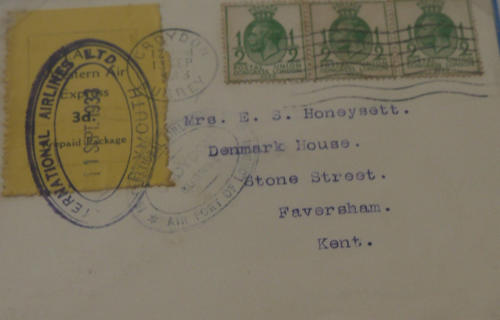
After a number of trial runs International Airways commenced their
air mail service on the 24th August 1933. After the initial official runs
of the 25th and 26th August the service became intermittent and
covers with dates after the 3rd September are uncommon. In fact the
air mail service ran up until the 11th September 1933, but covers with
that date are extremely scarce.
3. Portsmouth, Southsea and Isle of Wight Aviation. 7th December 1933. Air Ministry leaflets to Australia.

The dealer B. J. Tay arranged for a number of letters to be posted
through the airline to Australia and New Zealand. 21 covers were
in the first flight covers and just six were air ministry leaflets of
which only four are recorded as still being in existence. Despite
their extreme scarcity three of the four leaflets have appeared in
auction in the last year.
4.
London, Scottish and Provincial Airways Ltd. 13th May 1934

This air line flew its one and only air mail flight on the 13th May
1934 from Nottingham to Radlett. It was part of a Post Office
exhibition and only twenty covers were sent on the flight.
Although not as uncommon as some of the items in this list the
fact that only twenty were posted makes them quite scarce.
5. Highland Airways. First unofficial flight to Fair Isle 13th May 1937.
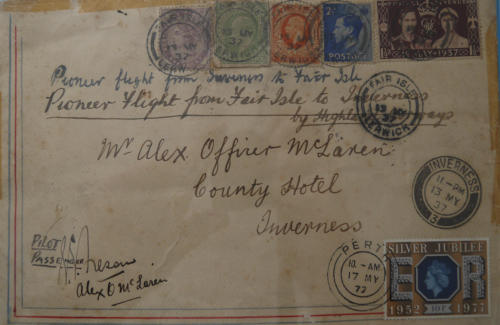
Captain Fresson flew the first flight to Fair Isle with the reporter
Sandy Maclaren to deliver coronation newspapers to the Island.
After two attempts he landed on the Island where he was met by
‘Old Mr Stout’ the postmaster and invited to the Islands Coronation
tea party. As well as the newspapers he delivered two covers signed
by himself and Sandy Maclaren. One of these is in a private
collection and the other in a museum.
6.
Spartan Airlines Ltd. First airmail flight covers to Southampton and Bembridge 1st October 1934.

That RAS had stopped flying to the Isle of Wight on the 30th
September escaped the notice of most air mail dealers and only
Francis Field was on the ball sufficiently to send a number of first
flight covers. They had no labels or cachets and are quite
unremarkable and now very scarce.
7.
Atlantic Coast Air Services Ltd. 18th February 1937. One penny bisect.

This private service between Devon and the Isle of Lundy
commenced in 1935. The air mail dealer L. Pitman had a
penchant for creating unusual covers and Lundy was one of his
favourite spots. He sent covers from Pacquebots, the Shetland
Isles and even from Tristan Da Cunha. In 1936 it was thought that
the issue of 1d stamps had run out and the authorities had
halved the stamps to make them go futher. This was not the case.
It is possible that Pitman did this to create a philatelic rarity but it
is more likely that there was no room for the large stamp on this
‘busy’ cover and it was cut in half to allow it to fit. There was also a
1/2d bisect which is even rarer but I have no image to show.
8. Allied Airways Ltd. 23rd November 1937. Williamson commemorative cover.

To commemorate the air mail contract between Aberdeen and
the Shetland islands a number of commemorative covers were
produced. In fact seven have been recorded. Most were pictorial
covers and the scarcest is a non pictorial cover known as the
Williamson covers which although fifty were produced the lack
of much interest has resulted in very few being kept and the
covers becoming very scarce.
9.
Aer Lingus. 1st July 1937. First flight cover Dublin to the Isle of Man.

Aer Lingus started a one way mail service between Dublin and
the Isle of Man in the first July 1937. The flights were seasonal
and took place in 1937, 1938 and 1939. First flight covers from
the first season are so scarce that Redgrove believed that none
existed. They do exist but they are one of the Inland mails of
the thirties great rarities.
10.
Scottish Airways. 31st July 1939. First flight company pictorial covers to North Ronaldsay.
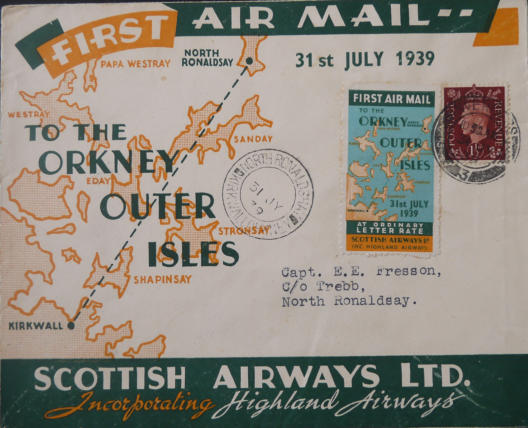
Redgrove thought these highly decorative covers were not
issued until after the first flight. In fact 5 covers were flown in
both directions to Officers of the Airline. They all of have
receiver postmarks to show they were actually flown on the
day.

Articles - Ten Rarities
Copyright
© 2020 Robert Farquharson All Rights Reserved

British Internal Airmails of the 1930’s
Section 5 - Directors Samples
These were printed to submit to the Directors of Provincial Airways to select the final colour combination. Some were put through the press the wrong way round which therefore created an inverted vignette. The errors were thought to have been leaked onto the philatelic market and were not destined for the powers that be. [**NOTE** I suspect this is incorrect. The samples did appear on the market, but they were probably not leaked. The inverted vignette may have been an initial accident, but there were far too many printed for them all to be accidents. I suspect the directors saw the potential in selling these to collectors. In the end they were packaged in packets and sold. (Francis Field). How they were first marketed is not known, but now they are sold as proofs when they are no such thing.]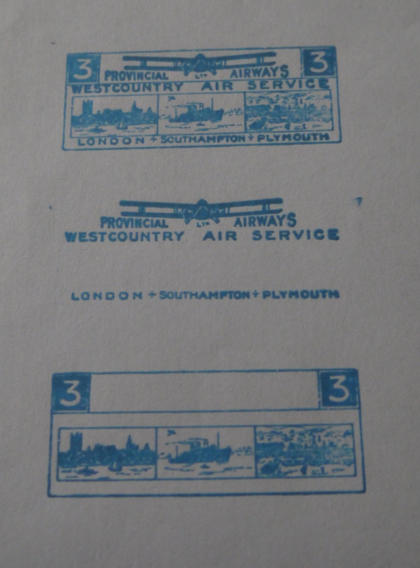
Blue on Ivory Card
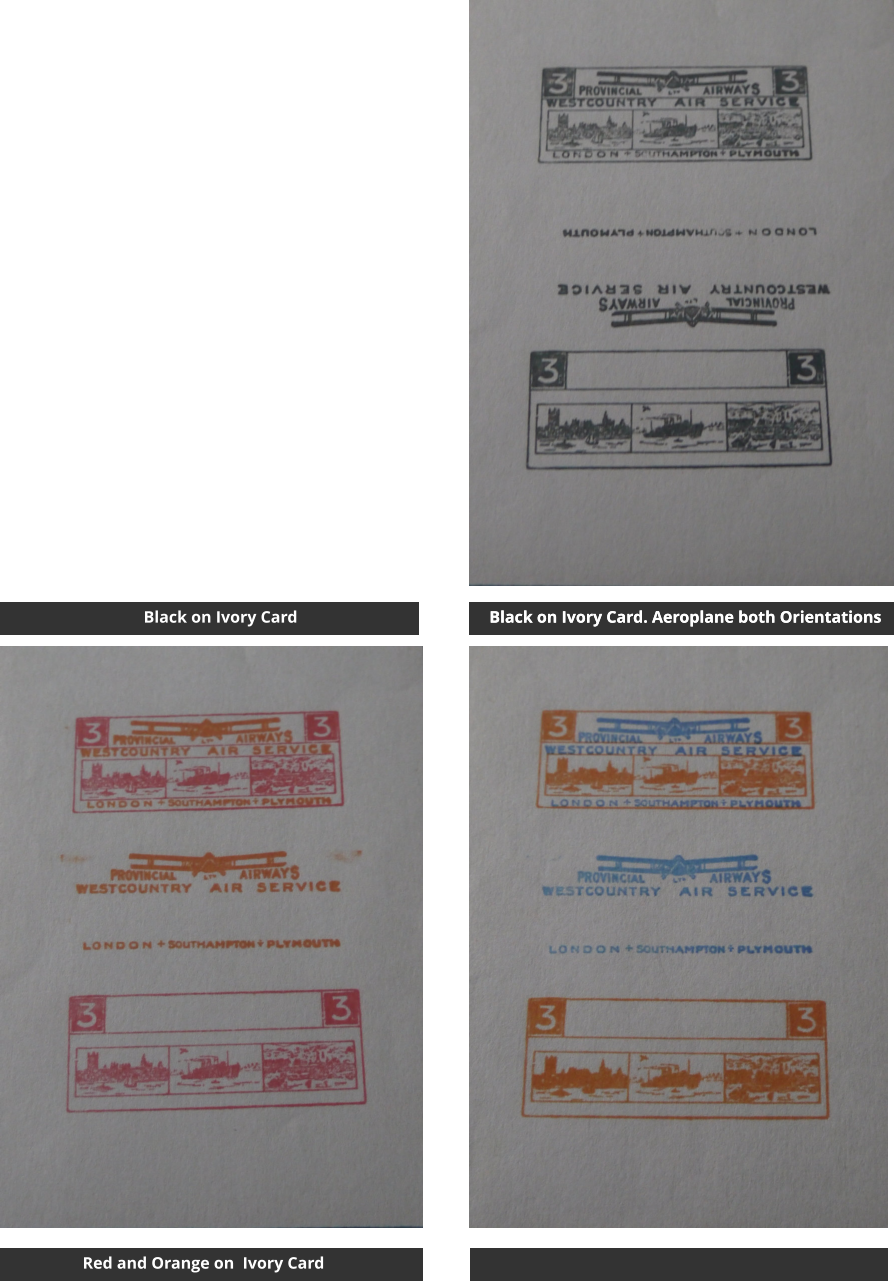
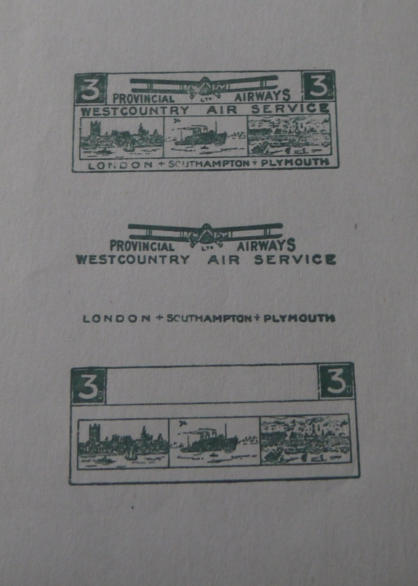



Blue on Ivory Card




































